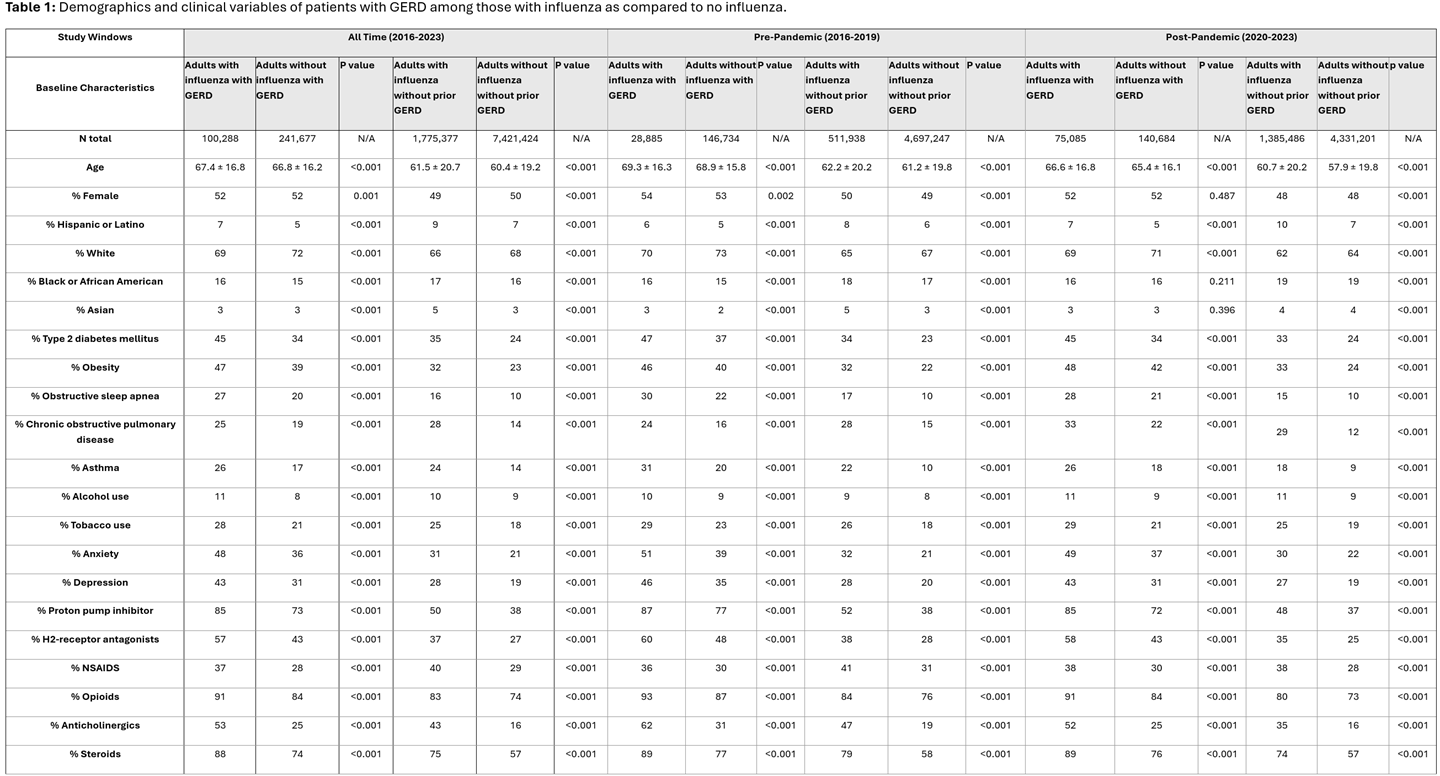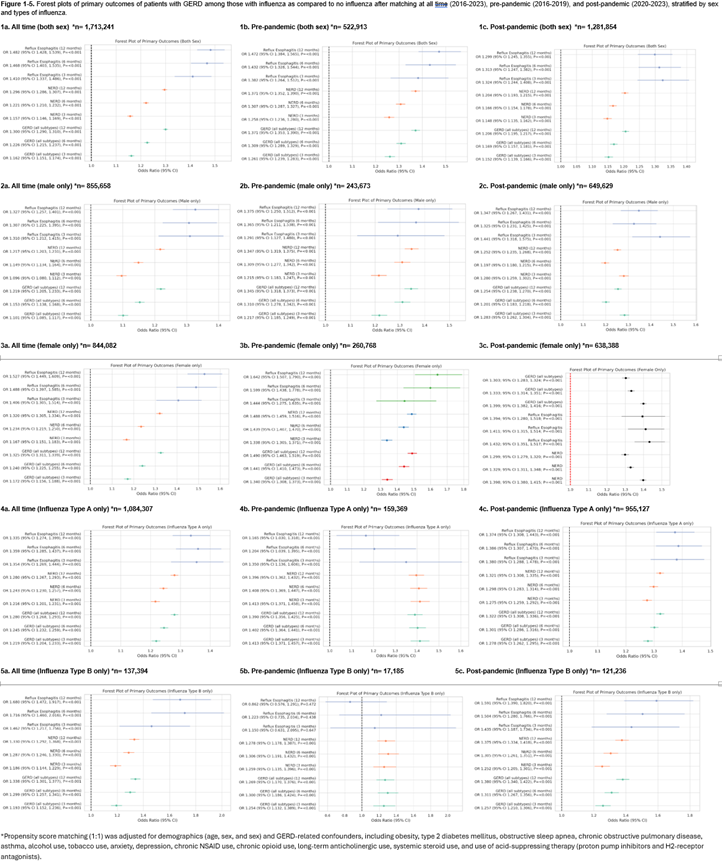Monday Poster Session
Category: Esophagus
P2780 - Influenza Infection Increases Risk of GERD and Its Subtypes Before and After the COVID-19 Pandemic
Monday, October 27, 2025
10:30 AM - 4:00 PM PDT
Location: Exhibit Hall

Yilin Song, MD (she/her/hers)
University of Maryland Medical Center
Baltimore, MD
Presenting Author(s)
Thai Hau Koo, MD1, Yilin Song, MD2, Rishi Chowdhary, MD3, Xue Leong, 1, Gengqing Song, MD4
1University of Sciences Malaysia Specialist Hospital, Kelantan, Kelantan, Malaysia; 2University of Maryland Medical Center, Baltimore, MD; 3Case Western Reserve University / MetroHealth, Cleveland, OH; 4Division of Gastroenterology and Hepatology, Metrohealth Medical Center, Cleveland, OH
Introduction: The risk and temporal patterns of gastroesophageal reflux disease (GERD) following an influenza infection remain poorly characterized. This study aimed to evaluate the incidence and risk of GERD and its subtypes, including erosive esophagitis (EE) and non-erosive reflux disease (NERD), in adults with influenza, comparing periods before and after the COVID-19 pandemic.
Methods: This retrospective cohort study analyzed data from the TriNetX database, including adult patients (≥18 years) diagnosed with influenza between January 1, 2016, and December 31, 2023, allowing up to 12 months of follow-up through January 1, 2025. Patients with prior GERD or concurrent viral infections, including COVID-19, were excluded. Two cohorts were studied: pre-pandemic (2016–2019) and post-pandemic (2020–2023). Propensity score matching (1:1) was performed based on demographics and GERD risk factors. Kaplan-Meier analysis and Cox proportional hazards models assessed GERD incidence at 3, 6, and 12 months post-influenza. Subgroup analyses evaluated GERD subtypes (EE, NERD), influenza types (A, B), and sex.
Results: Initial cohorts comprised 553,795 influenza patients and 4,531,438 controls pre-pandemic, and 1,500,582 influenza patients and 4,734,921 controls post-pandemic. After matching, final analysis included 511,938 influenza patients versus 4,697,247 controls pre-pandemic, and 1,385,486 influenza patients versus 4,331,201 controls post-pandemic. Influenza infection significantly increased GERD risk overall (OR 1.32; 95% CI 1.30-1.34; p< 0.001). GERD risk was slightly higher post-pandemic (OR 1.35; 95% CI 1.33-1.37; p< 0.001) compared to pre-pandemic (OR 1.26; 95% CI 1.23-1.29; p< 0.001), and remained consistent at 3, 6, and 12 months post-infection. Influenza significantly increased risks for both GERD subtypes: EE (OR 1.34; 95% CI 1.31-1.37; p< 0.001) and NERD (OR 1.28; 95% CI 1.25-1.31; p< 0.001). Females showed slightly higher GERD risk than males (EE: OR 1.37 vs. 1.31; NERD: OR 1.31 vs. 1.24; all p< 0.001). Both influenza A and B were significantly associated with increased GERD (A: OR 1.31, 95% CI 1.29-1.33; B: OR 1.28, 95% CI 1.24-1.32), EE (A: OR 1.33; B: OR 1.30), and NERD (A: OR 1.27; B: OR 1.25).
Discussion: Influenza infection significantly increases the risk of GERD and its subtypes, emphasizing the need for clinical vigilance.

Figure: Table 1: Demographics and clinical variables of patients with GERD among those with influenza as compared to no influenza.

Figure: Figure 1-5. Forest plots of primary outcomes of patients with GERD among those with influenza as compared to no influenza after matching at all time (2016-2023), pre-pandemic (2016-2019), and post-pandemic (2020-2023), stratified by sex and types of influenza.
Disclosures:
Thai Hau Koo indicated no relevant financial relationships.
Yilin Song indicated no relevant financial relationships.
Rishi Chowdhary indicated no relevant financial relationships.
Xue Leong indicated no relevant financial relationships.
Gengqing Song indicated no relevant financial relationships.
Thai Hau Koo, MD1, Yilin Song, MD2, Rishi Chowdhary, MD3, Xue Leong, 1, Gengqing Song, MD4. P2780 - Influenza Infection Increases Risk of GERD and Its Subtypes Before and After the COVID-19 Pandemic, ACG 2025 Annual Scientific Meeting Abstracts. Phoenix, AZ: American College of Gastroenterology.
1University of Sciences Malaysia Specialist Hospital, Kelantan, Kelantan, Malaysia; 2University of Maryland Medical Center, Baltimore, MD; 3Case Western Reserve University / MetroHealth, Cleveland, OH; 4Division of Gastroenterology and Hepatology, Metrohealth Medical Center, Cleveland, OH
Introduction: The risk and temporal patterns of gastroesophageal reflux disease (GERD) following an influenza infection remain poorly characterized. This study aimed to evaluate the incidence and risk of GERD and its subtypes, including erosive esophagitis (EE) and non-erosive reflux disease (NERD), in adults with influenza, comparing periods before and after the COVID-19 pandemic.
Methods: This retrospective cohort study analyzed data from the TriNetX database, including adult patients (≥18 years) diagnosed with influenza between January 1, 2016, and December 31, 2023, allowing up to 12 months of follow-up through January 1, 2025. Patients with prior GERD or concurrent viral infections, including COVID-19, were excluded. Two cohorts were studied: pre-pandemic (2016–2019) and post-pandemic (2020–2023). Propensity score matching (1:1) was performed based on demographics and GERD risk factors. Kaplan-Meier analysis and Cox proportional hazards models assessed GERD incidence at 3, 6, and 12 months post-influenza. Subgroup analyses evaluated GERD subtypes (EE, NERD), influenza types (A, B), and sex.
Results: Initial cohorts comprised 553,795 influenza patients and 4,531,438 controls pre-pandemic, and 1,500,582 influenza patients and 4,734,921 controls post-pandemic. After matching, final analysis included 511,938 influenza patients versus 4,697,247 controls pre-pandemic, and 1,385,486 influenza patients versus 4,331,201 controls post-pandemic. Influenza infection significantly increased GERD risk overall (OR 1.32; 95% CI 1.30-1.34; p< 0.001). GERD risk was slightly higher post-pandemic (OR 1.35; 95% CI 1.33-1.37; p< 0.001) compared to pre-pandemic (OR 1.26; 95% CI 1.23-1.29; p< 0.001), and remained consistent at 3, 6, and 12 months post-infection. Influenza significantly increased risks for both GERD subtypes: EE (OR 1.34; 95% CI 1.31-1.37; p< 0.001) and NERD (OR 1.28; 95% CI 1.25-1.31; p< 0.001). Females showed slightly higher GERD risk than males (EE: OR 1.37 vs. 1.31; NERD: OR 1.31 vs. 1.24; all p< 0.001). Both influenza A and B were significantly associated with increased GERD (A: OR 1.31, 95% CI 1.29-1.33; B: OR 1.28, 95% CI 1.24-1.32), EE (A: OR 1.33; B: OR 1.30), and NERD (A: OR 1.27; B: OR 1.25).
Discussion: Influenza infection significantly increases the risk of GERD and its subtypes, emphasizing the need for clinical vigilance.

Figure: Table 1: Demographics and clinical variables of patients with GERD among those with influenza as compared to no influenza.

Figure: Figure 1-5. Forest plots of primary outcomes of patients with GERD among those with influenza as compared to no influenza after matching at all time (2016-2023), pre-pandemic (2016-2019), and post-pandemic (2020-2023), stratified by sex and types of influenza.
Disclosures:
Thai Hau Koo indicated no relevant financial relationships.
Yilin Song indicated no relevant financial relationships.
Rishi Chowdhary indicated no relevant financial relationships.
Xue Leong indicated no relevant financial relationships.
Gengqing Song indicated no relevant financial relationships.
Thai Hau Koo, MD1, Yilin Song, MD2, Rishi Chowdhary, MD3, Xue Leong, 1, Gengqing Song, MD4. P2780 - Influenza Infection Increases Risk of GERD and Its Subtypes Before and After the COVID-19 Pandemic, ACG 2025 Annual Scientific Meeting Abstracts. Phoenix, AZ: American College of Gastroenterology.
